| 1 | Perth’s main venomous snake |
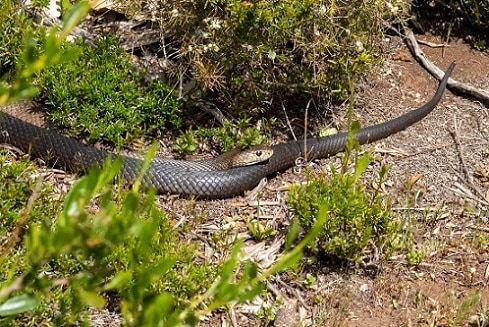
The Pseudonaja brown snake genus contains 9 members in Australia, the most notorious of which is the eastern brown snake. This aggressive species roams Sydney at will, totally dominating the east coast, but they cannot touch the southwest of Australia, which is instead ruled by a different species: the dugite (Pseudonaja affinis).
This species looks similar to the eastern brown at first glance, with a thin brown body and a head barely distinct from the neck. Dugites measure 1-1.2 metres, and the largest on record was a captive male measuring 212.5cm, which died in Perth zoo in December 1992. This had been brought to the zoo in November 1980 at a length of 135cm.
Dugites are found in western South Australia, and the southern regions of West Australia, including the bustling metropolis of Perth (population 4 million). Their temperament is similar to the eastern brown. They’re a naturally shy snake, hiding under cover objects like tiles or cracks between the walls.
But they’re also nervous and easily agitable, and will rear up into a sudden mid-air S-coil if frightened. They’ll make jabbing, rapid strikes at the aggressor, and another characteristic of the dugite is their high speed, which far outstrips the local death adder. The dugite is a venomous snake which doesn’t kill scores of people, but should never be underestimated.
| 2 | Common in city suburbs |
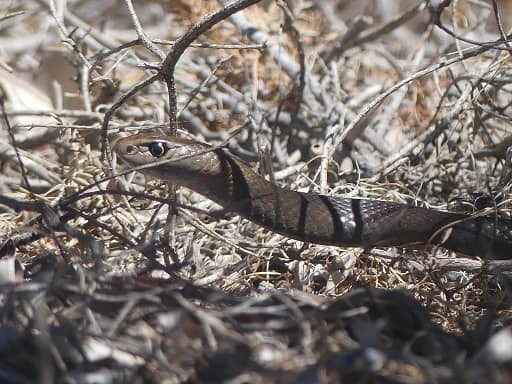
Naturally, the dugite inhabits open areas like sandy heathland, bushland and dry fields. But these days, they’re more likely to be found in suburbs. Over the last 100 years, numbers of the dugite have soared, as they have a close correlation with human activity. Urbanisation has advanced the dugite’s prospects, not reduced them. Dugites are an epidemic in the suburbs of Perth, and are the most common snake found in the city.
A study from Fremantle hospital (northern Perth) analysed snakebites from 1980 to 1990. It found that dugites were responsible for 70%. Most bites happened in backyards or suburban bush. A 1993 survey made 112 observations of dugites in the southern Perth suburbs.
One reason is the introduction of the non-native house mouse (Mus musculus), found globally, and an irresistible food source for the dugite. House mice can make up over 50% of a dugite’s prey, and they’ve mostly abandoned their native mammals, wowed by this exotic new flavour. People have found 5-7 dugites next to each other in patches of grass, somehow avoiding detection. This love of suburbs seems innate to the brown snake family, as eastern brown snakes have also grown more common in Sydney since 1950.
| 3 | Lurks in sheds and garden |
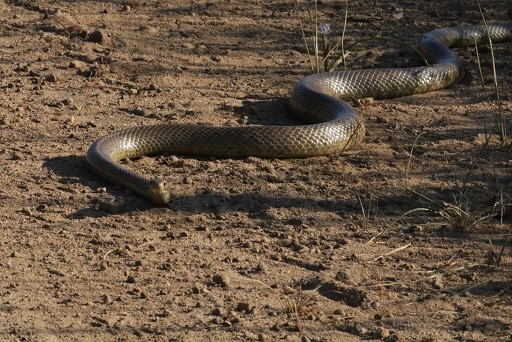
When cities are fully urbanised, replaced with towering skyscrapers and impenetrable slabs of concrete, the dugite disappears. They have their limits, but all they require for survival is a small patch of remnant bushland, or a park.
Dugites are experts at navigating these suburban environments. Dugites seem to have a fully realised 3d map in their brains, featuring every local shed, aviary and long patch of grass in their street. They prefer to hide under cover, whether it be brick wall gaps, piles of rubbish, or concrete slabs. Anyone can uncover a dugite while going about their daily life, or spot one slithering openly across a suburban street. Dugites are diurnal rather than nocturnal, although during the hottest weather, they move during early morning and late afternoon.
Dugites can even invade houses, though slightly less commonly than with Mozambique spitting cobras. On January 5th, 2011, a 7 year old boy from Perth was bitten 3 times in his bedroom, in the southeastern suburb of East Cannington. The boy was bitten twice on the toe, after which he woke up, and saw the dugite wrapped three times around his arm, before biting his finger. The boy received 4 doses of antivenom and survived. The dugite slithered into the shadows and was never found, even after reptile catchers checked every drawer and piece of furniture.
| 4 | Wild habitats: prefers sandy dunes |

When scientists scour natural bushland, they find that dugites are much less common, nowhere close to their concentrations in suburban gardens. In the wild, dugites can inhabit almost anywhere. Grassland, woodlands, bushland, and near semi-deserts are all acceptable for them. They’re an extremely flexible snake.
Dugites also appear in wet sclerophyll forests, containing towering eucalyptus trees. They do avoid closed canopy forests, with thick upper layers where all sunlight is blocked out. Likewise, they avoid exceptionally damp habitats like wetlands and swamps, but these are the only habitats dugites can’t survive in.
According to this 1996 study, the top wild habitats for Pseudonaja affinis are coastal sandy areas, with sweeping dunes and an abundance of heath, plus rock formations such as granite and limestone. They lurk in termite mounds, stick-ant nests, and the usual mammal and lizard burrows. Their love of coastal dunes means that dugites are a common beach snake too. Like in Perth, they love any human development. Even building a few cabins can cause the local dugite population to rise. You have to be very careful to avoid triggering an accidental snake explosion.
| 5 | Venom: targets blood clotting |
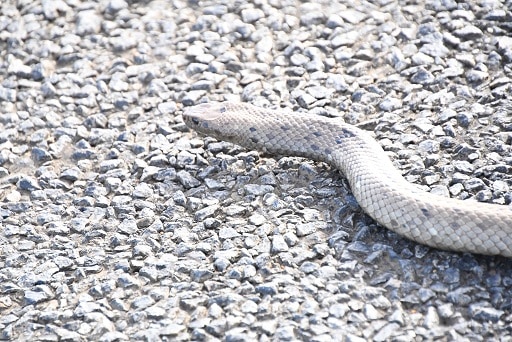
Dugite venom is capable of killing, and the most recent death happened in 2015, to a 45 year old woman who was bitten on her heel while walking in Fremantle. At its worse, a Pseudonaja affinis bite can trigger the following symptoms: cerebral haemorrhage, kidney damage, cardiac arrhythmia, cardiac arrest and paralysis. Dugites are slightly softened by having smaller than average teeth, which are incapable piercing thick boots or a winter coat. Likewise, antivenom is easily available. A Perth hospital that didn’t stock the antivenom would probably be shut down for negligence – hence the infrequent deaths. Dugites also cause more dry bites per average, bites where no venom is injected.
Spontaneous bleeding is the most common dugite symptom. Unlike an anticoagulant venom, where clotting materials are cleaved through directly, dugites have a procoagulant venom. Its toxins accelerate the production of clotting agents so dramatically that no raw materials remain to clot wounds.
The coagulation dangers were discovered in a 1972 study on 3 patients. The first had accelerated bleeding around the dugite bite site. The 2nd was more unusual: a menstruating woman whose flow significantly increased. The final dugite victim developed peteche; pinprick sized dots of red below the skin, representing leakages of blood.
In all 3 cases, blood clotting plummeted. Fibrinogen counts were massively reduced, the raw materials which convert to fibrin, the physical backbone of clots. There were also loose strands of useless fibrin appearing in the bloodstream.
| 6 | Targets the heart too |
One player in human blood coagulation is factor XII, which becomes a powerful clotting agent in its active form, factor VIIa. Dugite venom rapidly accelerates this activation of factor VII. Similarly, both dugites and eastern browns contain what’s called the “prothrombinase complex”: a mixture of factor Xa and factor Va which, when acting together, convert prothrombinase into its active thrombin form. The result is numerous pointless clots forming throughout the body, again depleting valuable clotting supplies.
Eastern brown snakes contain well researched neurotoxins, namely textilotoxin, which can trigger slurred speech and laboured breathing. These are less researched in dugites, but a short-chain neurotoxin was identified in dugite venom for the first time in 2002. This study had other interesting results. Dugite venom slowed the beating of cardiac cells from rats, explaining the cardiac arrhythmia reported in humans.
Dugite venom also changes with age, as juveniles have virtually no coagulation dangers. Juvenile venom had no effect on factor VII, and lacked the prothrombinase complex.
| 7 | Diet: a mouse addict |
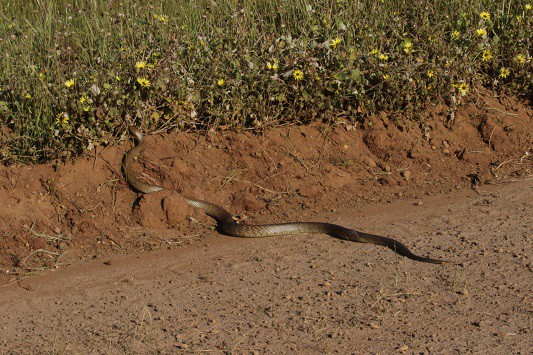
Dugites prey on a mixture of mammals and reptiles. They’re active foragers rather than ambush snakes, and disable prey using fast-acting venom. A 2022 study dissected 568 dugites, of which 151 contained prey items. The diet breakdown was as follows: 120 mammals, 114 reptiles, plus 59 detached reptile tails. This made for a slight bias towards reptiles overall, but this was caused by juveniles eating reptiles exclusively. The larger they became, the more mammals they added, without phasing out reptiles completely.
The smallest reptile was a southwestern cool skink, while the largest was a shingleback skink. Overall, 18 species of reptiles were discovered. Mammals were another story entirely. 67% were the invasive house mouse, while 13% were juvenile rodents which couldn’t be identified. There was just one native mammal, a Mitchell’s hopping mouse.
Scientists once tried to feed a dugite a slender tree frog frog. The dugite handled the amphibian in its coils, interested, but the second its inner mouth touched the frog, it recoiled in disgust, reacting to a secretion in its skin. They rarely eat birds either, and fellow snakes are only occasional meals.
| 8 | Falls for lizard deceptions |
Another discovery was that adult dugites ate prey by the head, while juveniles seized them by the tail. This sometimes worked against them. Young dugites routinely fell victim to the oldest trick in the book: when lizards detach their own tails to escape a predator’s clutches. In 59 dugites, a lizard tail was found in their stomach but without an actual lizard. These were inexperienced young dugites who didn’t know the ways of the world yet. Snakes themselves use “caudal autonomy”, detaching their own tail to escape a predator’s claws/talons, but these dugites were falling victim to it. Unlike snakes, lizards are able to regrow their tail.
Dugites also have a shift in skull shape with age that allows them to swallower larger prey. 46 dugite skulls were analysed, and as juveniles, they had smooth, bulbous skulls with relatively shorter jaw bones. With age, their skulls became more wrinkled and corrugated, with larger lower and upper jaw bones (plus attachments) which could extend further, and therefore increase the power of their mouths to gape freakishly wide.
Another change with age was discovered in a 2022 study, specifically in the teeth. Juveniles had blunter fangs compared to adults, and this was theorised to be for gripping hard scaled lizards, to prevent them from darting away.
| 9 | Sticks to a narrow territory |
Dugites are an egg-laying species, and produce average quantities, with an efficiently laid batch of 11-35. They abandon their eggs instantly, with no parental care like a timbre rattlesnake. These eggs take 53 to 105 days to hatch. Males have a tendency to wrestle furiously, and male dugites are slightly longer than females (which is normal for species that wrestle).
By living in suburbs alongside families, dugites often get whacked to death. To spare them, people have considered relocating them, but a 2018 study found that this is unhealthy for dugites. 10 dugites were implanted with telemetry packages, consisting of GPS data loggers and radio-telemetry transmitters. 4 dugites were moved over 3km away, while 6 were moved 0-200 metres away.
All four dugites moved long distances died, whether to bird predation or oncoming vehicles. It’s theorised that they were trying desperately to find a familiar landmark, and thus slithering around more, leading them into danger’s arms. Meanwhile, 50% of the short distance snakes perished over the study. Apparently, dugites have a local neighbourhood they grow to love and be familiar with.
| 10 | Three subspecies |
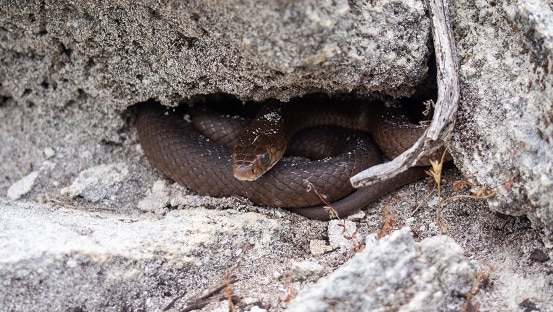
The dugite has three subspecies, two living on offshore islands. Overwhelmingly the most common is simply titled Pseudonaja affinis affinis. This is the standard dugite in pictures, olive brown with spots, but occasionally much darker, particularly in the eastern territories. It’s common for juveniles to have small black spots, which expand and cover the entire body with age. P. affinis affinis is found in Perth, Fremantle, and all the mainland territories of southwestern Australia.
Then you have Pseudonaja affinis exilis, which is exiled to Rottnest Island 20km west of Fremantle. This island formerly consisted of closed canopy forests, but is now developed by humans, particularly on the eastern end. Rottnest island receives thousands of visitors monthly, and the local dugites are more common than ever.
The final subspecies, Pseudonaja affinis tanneri, lives only on Boxer and Figure of Eight Islands, 20-30km off the coast of Esperance. These are remote and uninhabited, and some of the only research came in 1994, when David Knowles visited Figure Of Eight island and found 9 dugites on a rocky outcrop, with two of the males wrestling furiously. These two island subspecies tend to be darker than the mainland subspecies.
